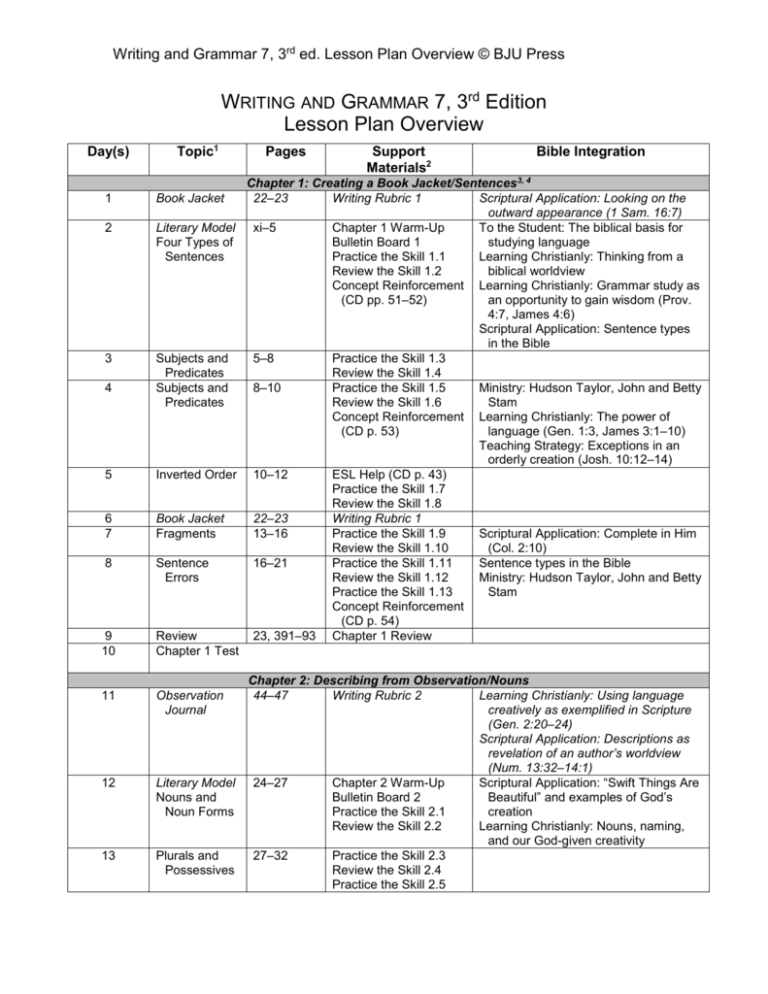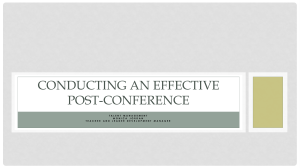Writing & Grammar 7, 3rd ed. Lesson Plan Overview
advertisement

Writing and Grammar 7, 3rd ed. Lesson Plan Overview © BJU Press WRITING AND GRAMMAR 7, 3rd Edition Lesson Plan Overview Day(s) 1 2 3 4 5 6 7 8 9 10 Topic1 Pages Support Materials2 Bible Integration Chapter 1: Creating a Book Jacket/Sentences3, 4 Book Jacket 22–23 Writing Rubric 1 Scriptural Application: Looking on the outward appearance (1 Sam. 16:7) Literary Model xi–5 Chapter 1 Warm-Up To the Student: The biblical basis for Four Types of Bulletin Board 1 studying language Sentences Practice the Skill 1.1 Learning Christianly: Thinking from a Review the Skill 1.2 biblical worldview Concept Reinforcement Learning Christianly: Grammar study as (CD pp. 51–52) an opportunity to gain wisdom (Prov. 4:7, James 4:6) Scriptural Application: Sentence types in the Bible Subjects and 5–8 Practice the Skill 1.3 Predicates Review the Skill 1.4 Subjects and 8–10 Practice the Skill 1.5 Ministry: Hudson Taylor, John and Betty Predicates Review the Skill 1.6 Stam Concept Reinforcement Learning Christianly: The power of (CD p. 53) language (Gen. 1:3, James 3:1–10) Teaching Strategy: Exceptions in an orderly creation (Josh. 10:12–14) Inverted Order 10–12 ESL Help (CD p. 43) Practice the Skill 1.7 Review the Skill 1.8 Book Jacket 22–23 Writing Rubric 1 Fragments 13–16 Practice the Skill 1.9 Scriptural Application: Complete in Him Review the Skill 1.10 (Col. 2:10) Sentence 16–21 Practice the Skill 1.11 Sentence types in the Bible Errors Review the Skill 1.12 Ministry: Hudson Taylor, John and Betty Practice the Skill 1.13 Stam Concept Reinforcement (CD p. 54) Review 23, 391–93 Chapter 1 Review Chapter 1 Test 11 Observation Journal 12 Literary Model Nouns and Noun Forms 13 Plurals and Possessives Chapter 2: Describing from Observation/Nouns 44–47 Writing Rubric 2 Learning Christianly: Using language creatively as exemplified in Scripture (Gen. 2:20–24) Scriptural Application: Descriptions as revelation of an author’s worldview (Num. 13:32–14:1) 24–27 Chapter 2 Warm-Up Scriptural Application: “Swift Things Are Bulletin Board 2 Beautiful” and examples of God’s Practice the Skill 2.1 creation Review the Skill 2.2 Learning Christianly: Nouns, naming, and our God-given creativity 27–32 Practice the Skill 2.3 Review the Skill 2.4 Practice the Skill 2.5 Writing and Grammar 7, 3rd ed. Lesson Plan Overview © BJU Press 14 Plurals and Possessives 33–35 15 Common and Proper Nouns Count and Noncount Nouns Compound Nouns 35–37 Observation Journal Review 44–47 20 Chapter 2 Test History of the English Language 47 21 Literary Model Verbs 22 Transitive and Intransitive Verbs 23 Linking Verbs 24 Summary 25 Auxiliaries 60–62 26 Principal Parts 62–64 27 Simple Tenses 65–68 28 Perfect Tenses 68–75 16 17 18 19 Review the Skill 2.6 Practice the Skill 2.7 Review the Skill 2.8 Concept Reinforcement (CD p. 55) Use the Skill 2.9 Practice the Skill 2.10 Review the Skill 2.11 37–39 Practice the Skill 2.12 Review the Skill 2.13 39–41 Practice the Skill 2.14 Review the Skill 2.15 Use the Skill 2.16 Writing Rubric 2 42–43, 395–96 Cumulative Review 2.17 Chapter 2 Review Enrichment: Significance of names in the Bible Scriptural Application: Observing God’s hand in life (Ps. 19:1–2) Scriptural Application: 1 Kings 7:47–51 Chapter 3: Persuading an Audience/Verbs 48–52 Chapter 3 Warm-Up Bulletin Board 3 Practice the Skill 3.1 Review the Skill 3.2 53–55 Practice the Skill 3.3 Review the Skill 3.4 Concept Reinforcement (CD p. 56) 55–57 Practice the Skill 3.5 Learning Christianly: God as the “I AM” Review the Skill 3.6 57–60 Practice the Skill 3.7 Scriptural Application: Linking verbs in Practice the Skill 3.8 the KJV Concept Reinforcement Scriptural Application: Sentence (CD p. 57) patterns showing the order of God’s Review the Skill 3.9 creation Practice the Skill 3.10 Review the Skill 3.11 Practice the Skill 3.12 Review the Skill 3.13 Practice the Skill 3.14 Practice the Skill 3.15 Review the Skill 3.16 Practice the Skill 3.17 Review the Skill 3.18 Practice the Skill 3.19 Review the Skill 3.20 ESL Help (CD p. 44) Practice the Skill 3.21 Joshua and Caleb Ministry: John and Betty Stam, John and Isobel Kuhn Scriptural Application: The neverchanging Christ (Heb. 13:8) Ministry: Charles and Susannah Spurgeon Scriptural Application: The term perfect in the KJV (James 1:4) Additional Resources: John and Betty Stam, John and Isobel Kuhn, and Writing and Grammar 7, 3rd ed. Lesson Plan Overview © BJU Press 29 Review 76–77, 397–99 30 Chapter 3 Test Critical Thinking Ads and Announcements 80–81 31–32 33 34 35 36–37 Literary Model Pronouns and Antecedents Personal Pronouns Demonstrative , Interrogative, Reflexive, and Intensive Pronouns Letter to a Pen Pal Writing Worksheet 3 Writing Rubric 3 Proverbs 30:25–27 Scriptural Application: Using persuasion as a tool for God (Acts 18:4) Scriptural Application: Persuasion modeled in the Bible (Dan. 3) Chapter 4: Writing to a Pen Pal/ Pronouns 82–85 Chapter 4 Warm-Up The story of Moses Practice the Skill 4.1 Review the Skill 4.2 86–88 Practice the Skill 4.3 David and Goliath (1 Sam. 17) Review the Skill 4.4 Learning Christianly: Reasons to excel Concept Reinforcement in writing and grammar (Gen. 1:27– (CD p. 59) 28) Elijah and the prophets of Baal 88–93 Practice the Skill 4.5 Ministry: Samuel and Susannah Wesley Review the Skill 4.6 Practice the Skill 4.7 Review the Skill 4.8 98–99 Bulletin Board 4 Writing Worksheet 4 Writing Rubric 4 Practice the Skill 4.9 Review the Skill 4.10 Review the Skill 4.11 Review the Skill 4.12 Concept Reinforcement (CD p.60) Cumulative Review 4.13 Chapter 4 Review Writing Worksheet 4 Writing Rubric 4 Indefinite Pronouns 93–96 39 Review Letter to a Pen Pal 97–98, 401–2 98–99 41 Charles H. Spurgeon Learning Christianly: Names of God that describe His actions Psalm 10:4–7 77–81 38 40 Review the Skill 3.22 Concept Reinforcement (CD p. 58) Use the Skill 3.23 Cumulative Review 3.24 Chapter 3 Review Scriptural Application: Edifying through personal correspondence (3 John 1– 2) Scriptural Application: Your life as a letter to observers (2 Cor. 3:2) Scriptural Application: Avoiding the sins of self-centeredness and pride (Isa. 14:13–15) Scriptural Application: Edifying through personal correspondence (3 John 1– 2) Scriptural Application: Your life as a letter to observers (2 Cor. 3:2) Chapter 4 Test Story of Ruth Chapter 5: Creating a Poem from Prose/ Adjectives Literary Model 100–103 Chapter 5 Warm-Up Adjectives Bulletin Board 5 Practice the Skill 5.1 Review the Skill 5.2 Writing and Grammar 7, 3rd ed. Lesson Plan Overview © BJU Press 42 Adjective Comparisons 104–7 Use the Skill 5.3 Practice the Skill 5.4 Review the Skill 5.5 Concept Reinforcement (CD p. 61) 43 108–10 44 Nouns as Adjectives Articles 45 Possessives 112–16 46 Proper Adjectives 116–18 47 Review 118–20 Practice the Skill 5.6 Review the Skill 5.7 Practice the Skill 5.8 Review the Skill 5.9 ESL Helps (CD pp. 45– 46) Practice the Skill 5.10 Review the Skill 5.11 Concept Reinforcement (CD p. 62) Practice the Skill 5.12 Review the Skill 5.13 Review the Skill 5.14 Cumulative Review 5.15 48 124–25 49 50 Critical Thinking Review Chapter 5 Test 403–4 Chapter 5 Review 51–52 Found Poems 121–23 Writing Worksheet 5 Writing Rubric 5 53 54 55 56–57 58 59 60 111–12 Learning Christianly: Humans’ unique ability to describe Proverbs 17:22 Scriptural Application: God’s glory seen in the scope of language Ministry: Martin Luther Christians and prayer Learning Christianly: Moral aspects of language Ministry: Martin and Katie Luther Esther 1:3–6 Scriptural Application: Words fitly chosen (Prov. 25:11) Scriptural Application: God’s wise plans (Rom. 8:28) Chapter 6: Reporting a Family Tradition/Adverbs Literary Model 126–29 Chapter 6 Warm-Up Scriptural Application: Adverbs in the Adverbs Bulletin Board 6 Bible Teaching Help 6 Gratitude (1 Thess. 5:18) Practice the Skill 6.1 Jesus heals ten lepers Review the Skill 6.2 Adverb 129–31 Practice the Skill 6.3 Positions Review the Skill 6.4 Adverb 132–35 Practice the Skill 6.5 Scriptural Application: The importance Comparisons Review the Skill 6.6 of choices (Matt. 7:20) Practice the Skill 6.7 Family 140–41 Writing Worksheet 6 Scriptural Application: Honoring your Tradition Writing Rubric 6 parents (Eph. 6:2–3) Report Scriptural Application: Keeping the Sabbath (Ex. 20: 3–11) Practice 136–38 Review the Skill 6.8 Learning Christianly: How we do what Use the Skill 6.9 we do (Col. 3:16) Concept Reinforcement (CD p. 63) Review 139–40, Cumulative Review 1 Sam. 18:14–15 405–6 6.10 Chapter 6 Review Chapter 6 Test 141 History of the English Writing and Grammar 7, 3rd ed. Lesson Plan Overview © BJU Press 61 62 63 64 65 66 67 68 69 70 Language Chapter 7: Describing a Process/Prepositions, Conjunctions, and Interjections Process 161 Scriptural Application: Clear and Writing thorough explanations (Neh. 8:8) Scriptural Application: God’s clear instructions (2 Tim. 3:16–17) Literary Model 142–46 Chapter 7 Warm-Up Psalm 70 Prepositions Practice the Skill 7.1 Naaman (2 Kings 5) and Review the Skill 7.2 Prepositional Phrases Prepositional 146–49 Practice the Skill 7.3 Scriptural Application: Language as a Phrase Review the Skill 7.4 reflection of God’s orderliness Functions ESL Helps (CD pp. 47– 48) Concept Reinforcement (CD p. 64) Bulletin Board 7 Prepositions 149–51 Practice the Skill 7.5 Psalm 70 and Adverbs Review the Skill 7.6 Conjunctions 151–54 Practice the Skill 7.7 Learning Christianly: The unity of Review the Skill 7.8 Creation Process 161 Writing Worksheet 7 Scriptural Application: Clear and Writing Writing Rubric 7 thorough explanations (Neh. 8:8) Scriptural Application: God’s clear instructions (2 Tim. 3:16–17) Interjections 155–58 Practice the Skill 7.9 Learning Christianly: Using words Use the Skill 7.10 profanely Review the Skill 7.11 Scriptural Analysis: Wisdom in Proverbs Review the Skill 7.12 Queen Esther Teaching Help 7 Concept Reinforcement (CD p. 65) Review 159–60, Cumulative Review 2 Timothy 3:16–17; Rev. 5:11–12; 407–9 7.13 Proverbs 24:5 Chapter 7 Review Review Time in the Bible Chapter 7 Test Bible facts; story of Mary and Martha Chapter 8: Dramatizing a Scene/Clause Structure 175–80 Writing Worksheet 8 Scriptural Application: Dramatizing a Writing Rubric 8 scene (Rev. 1:10–11, 17) Scriptural Application: Esther and dramatic scenes Scriptural Application: God’s plan for us 71 Dramatizing a Scene 72 Literary Model Phrases and Clauses 162–66 73 Simple and Compound Sentences 166–69 Chapter 8 Warm-Up Bulletin Board 8 Practice the Skill 8.1 Review the Skill 8.2 Concept Reinforcement (CD p. 66) Practice the Skill 8.3 Review the Skill 8.4 Ministry: William Carey The Psalms Enrichment: Summarize a Bible story Ministry: William Carey Writing and Grammar 7, 3rd ed. Lesson Plan Overview © BJU Press 74 Complex and CompoundComplex Sentences Writing Across the Curriculum Idioms Dramatizing a Scene 169–71 175–80 Writing Worksheet 8 Writing Rubric 8 77 Practice 171–73 Use the Skill 8.7 78 Review 173–74 Cumulative Review 8.8 75 76 79 80 81–90 91 92 93 94 95 96 97 98 99 100 101 Practice the Skill 8.5 Review the Skill 8.6 Concept Reinforcement (CD pp. 67–68) 180 Scriptural Application: Biblical characters were people just Iike us (James 5:17) Scriptural Application: John 2:13–15 Learning Christianly: Complex sentences in Scripture (Eph. 1:3–14) Scriptural Application: Proverbs 25:21– 22 Review 411–12 Chapter 8 Review Chapter 8 Test Midterm Review and Midterm Examination Chapter 9: Taking Notes/Subject-Verb Agreement Taking Notes 194–95 Writing Rubric 9 Scriptural Application: Proverbs 7:1,3 Scriptural Application: Remembering God’s Words (Deut. 8:11, 19–20) Subject-Verb 182–86 Chapter 9 Warm-Up Scriptural Application: Friends (Amos Agreement Bulletin Board 9 3:3) ESL Helps (CD pp. 49– The story of Ruth 50) Learning Christianly: Pursuing Practice the Skill 9.1 excellence in grammar and writing Review the Skill 9.2 Obedience Agreement: 186–88 Practice the Skill 9.3 Indefinite Concept Reinforcement Pronouns (CD p. 69) Agreement: 188–89 Review the Skill 9.4 Compound Subjects Review 189–91 Practice the Skill 9.5 Review the Skill 9.6 Concept Reinforcement (CD pp. 70–71) Taking Notes 194–95 Writing Rubric 9 Scriptural Application: Proverbs 7:1,3 Scriptural Application: Remembering God’s Words (Deut. 8:11, 19–20) Agreement: 191–92 Practice the Skill 9.7 Common Problems Practice 192–94 Concept Reinforcement Angels in the Bible (CD p. 72) Review the Skill 9.8 Use the Skill 9.9 Review 413–14 Chapter 9 Review Chapter 9 Test Biblical discussion of and examples of faith Chapter 10: Defining Terms/Pronoun-Antecedent Agreement Defining 205–6 Writing Rubric 10 Scriptural Application: Biblical hope Terms (Heb. 11:1; Tit. 2:11–13) Writing and Grammar 7, 3rd ed. Lesson Plan Overview © BJU Press 102 Agreement: Personal Pronouns Practice 196–98 Chapter 10 Warm-Up Bulletin Board 10 198–99 200 107 Agreement: Indefinite Pronouns Connotative language Defining Terms Practice Practice the Skill 10.1 Review the Skill 10.2 Concept Reinforcement (CD p. 73) Teaching Help 9 and 10 108 Review 203–5 109 110 Review 415–16 Chapter 10 Test 111 Giving Directions 112 Pronoun Case: Objective and Subjective 113 Pronoun Case: Objective and Subjective Pronoun Case: Potential Problems Reflexive and Intensive Pronouns Giving Directions Clear Pronoun Reference 103 104 105 106 114 115 116 117 118 Review Learning Christianly: The Bible’s use of the masculine pronoun for God Scriptural Application: Correct communication (1 Cor. 14:33) 207 205–6 Writing Rubric 10 201–2 Practice the Skill 10.3 Review the Skill 10. 4 Use the Skill 10.5 Cumulative Review 10.6 Chapter 10 Review The reality of hope (Prov. 13:12) Chapter 11: Giving Directions/Pronoun Usage 227–28 Writing Worksheet 11 Scriptural Application: Directions in Writing Rubric 11 Scripture (Num. 13:17–18; Luke 22:8– 12) 208–12 Chapter 11 Warm-Up Learning Christianly: Grammar and Bulletin Board 11 reading Practice the Skill 11.1 Review the Skill 11.2 Concept Reinforcement (CD p. 74) 213–16 Practice the Skill 11.3 Scriptural Application: Avoiding offense Review the Skill 11.4 in communication (Eph. 4:29) Practice the Skill 11.5 Review the Skill 11.6 216–19 Practice the Skill 11.7 Review the Skill 11.8 219–20 Practice the Skill 11.9 Concept Reinforcement (CD p. 75) Writing Worksheet 11 Writing Rubric 11 Review the Skill 11.10 Practice the Skill 11.11 227–28 221–23 224–26 Review the Skill 11.12 Use the Skill 11.13 Concept Reinforcement (CD pp. 76–77) Cumulative Review Learning Christianly: Writing and grammar as part of your personal testimony Writing and Grammar 7, 3rd ed. Lesson Plan Overview © BJU Press 11.14 Review 417–19 Chapter 11 Review Chapter 11 229–31 Test Critical Thinking Chapter 12: Explaining the Rules of a Game or Sport/Using Adjectives and Adverbs Correctly Explaining the 242–44 Writing Worksheet 12 Scriptural Application: The Golden Rule 121 Rules Writing Rubric 12 (Matt. 7:12) and games Scriptural Application: God’s instructions for the tabernacle Scriptural Application: Good and well in 122 Distinguishing 232–34 Chapter 12 Warm-Up Adjectives Bulletin Board 12 Scripture and Adverbs Practice the Skill 12.1 Scriptural Application: Adverbs in Concept Reinforcement Scripture (CD p. 78) 123 Practice 235–36 Review the Skill 12.2 Learning Christianly: Why good Practice the Skill 12.3 communication is difficult Review the Skill 12.4 119 120 124 Double Negatives and Comparisons 237–39 125 Redundancy Writing Across the Curriculum Explaining the Rules Practice Review 245 126 127 128 129 130 131–32 133 134 135 136 242–44 239–40 241 Practice the Skill 12.5 Review the Skill 12.6 Concept Reinforcement (CD p. 79) Writing Across the Curriculum: Biblical freedom (John 8:36) Writing Worksheet 12 Writing Rubric 12 Use the Skill 12.7 Cumulative Review 12.8 Chapter 12 Review Scriptural Application: God’s instructions (Ps. 32:8) Review 421–22 Chapter 12 Test Chapter 13: Answering Essay Questions/Using Troublesome Words Correctly In-class Essay 263–64 Writing Worksheet 13 Learning Christianly: The biblical Writing Rubric 13 connection between writing and grammar Scriptural Application: Thoughtful speech (Prov. 29:20) Scriptural Application: Psalm 96:10–13 Troublesome 246–49 Chapter 13 Warm-Up Learning Christianly: Mastering the Verbs Bulletin Board 13 details of language for God and others Practice the Skill 13.1 Concept Reinforcement (CD p. 80) Other Trouble- 250–52 Use the Skill 13.2 some Words Practice the Skill 13.3 Dead 265 Metaphors Writing Across the Curriculum Homonyms 253–56 Use the Skill 13.4 Writing and Grammar 7, 3rd ed. Lesson Plan Overview © BJU Press Practice the Skill 13.5 Use the Skill 13.6 Concept Reinforcement (CD p. 81) Practice the Skill 13.7 Use the Skill 13.8 Use the Skill 13.9 Cumulative Review 13.10 Chapter 13 Review 137 Homonyms 257–61 138 Review 262 139 140 Review 423–24 Chapter 13 Test Chapter 14: Writing a Biographical Sketch/Capitalization4 Biographical 283–85 Writing Worksheet 14 Scriptural Application: Your life’s record Sketch Writing Rubric 14 (2 Kings 22:2) 141 142 Proper Nouns: People and Places 266–70 143 Other Proper Nouns 270–75 144 Titles 275–77 145 Proper Adjectives and Other Words Biographical Sketch Common Nouns Review 277–79 146 147 148 149 150 151 152 153 154 155 156 283–85 279–81 281–82 Chapter 14 Warm-Up Bulletin Board 14 Practice the Skill 14.1 Review the Skill 14.2 Practice the Skill 14.3 Review the Skill 14.4 Review the Skill 14.5 Concept Reinforcement (CD pp. 82–83) Practice the Skill 14.6 Review the Skill 14.7 Practice the Skill 14.8 Review the Skill 14.9 Scriptural Application: Shining a light in the world (Matt. 5:16) Writing Worksheet 14 Writing Rubric 14 Practice the Skill 14.10 Review the Skill 14.11 Use the Skill 14.12 Cumulative Review 14.13 Chapter 14 Review Scriptural Application: Respect for others (Phil. 2:3) Learning Christianly: Capitalizing God’s names Scriptural Application: Interrelated lessons in school and in life Review 425–27 Chapter 14 Test Chapter 15: Crafting a Letter to the Editor/Punctuation 4 End Marks 286–89 Chapter 15 Warm-Up Scriptural Application: Building Teaching Help 15 understanding (Isa. 28:10) Practice the Skill 15.1 Review the Skill 15.2 Periods 289–91 Practice the Skill 15.3 Review the Skill 15.4 Commas in a 291–93 Practice the Skill 15.5 Series Review the Skill 15.6 Practice 294–95 Use the Skill 15.7 Commas to 295–97 Practice the Skill 15.8 Separate Review the Skill 15.9 Concept Reinforcement (CD pp. 84–85) Commas in 298–304 Practice the Skill 15.10 Ministry: C.T. Studd, David Livingstone, Letters and Review the Skill 15.11 and Mary Slessor with QuotaPractice the Skill 15.12 Joseph (Gen. 37–50) Writing and Grammar 7, 3rd ed. Lesson Plan Overview © BJU Press 157 tions, Dates, and Addresses Quotation Marks and Underlining for Italics 305–9 158 Apostrophes and Hyphens 310–14 159 160 Review Chapter 15 Test Letter to the Editor 429–30 161 162 163 164 165 166 167 168 169 170 171–80 315–17 Review the Skill 15.13 Review the Skill 15.14 Scriptural Application: Doing things decently and in order (1 Cor. 14:40) Practice the Skill 15.15 Review the Skill 15.16 Practice the Skill 15.17 Review the Skill 15.18 Concept Reinforcement (CD pp. 86–87) Practice the Skill 15.19 Review the Skill 15.20 Concept Reinforcement (CD p. 88) Practice the Skill 15.21 Review the Skill 15.22 Use the Skill 15.23 Cumulative Review 15.24 Concept Reinforcement (CD p. 89) Chapter 15 Review Scriptural Application: Being known by your works (Prov. 20:11) Ministry: Dr. Walter Wilson Mordecai’s integrity Learning Christianly: Sharing the beauty of Creation (Gal. 5:14) Writing Worksheet 15 Scriptural Application: Writing as an Writing Rubric 15 instrument of redemption (1 Pet. 3:15) Bulletin Board 15 Chapter 16: Evaluating a Science Fair Project Report/Spelling Report 329–31 Writing Worksheet 16 Scriptural Application: Good judgment Evaluation Writing Rubric 16 (Phil. 1:9–10) Scriptural Application: Psalm 139:23, James 1:2–4 Spelling Hints 318–22 Chapter 16 Warm-Up Verbs and Bulletin Board 16 Noun Plurals Practice the Skill 16.1 Use the Skill 16.2 ie and ei 322–24 Practice the Skill 16.3 Learning Christianly: Opportunities for Use the Skill 16.4 English speakers Concept Reinforcement Spreading the Gospel (CD p. 90) Adding 325–27 Practice the Skill 16.5 Learning Christianly: The tool of Suffixes Use the Skill 16.6 persuasion Letter to the 315–17 Writing Worksheet 15 Scriptural Application: Writing as an Editor Writing Rubric 15 instrument of redemption (1 Pet. 3:15) Report 329–31 Writing Worksheet 16 Scriptural Application: Good judgment Evaluation Writing Rubric 16 (Phil. 1:9–10; John 13:35) Scriptural Application: Psalm 139:23, James 1:2–4 Review 327–28 Review the Skill 16.7 Concept Reinforcement (CD pp. 91–92) Cumulative Review 16.8 Review 431–33 Chapter 16 Review Chapter 16 Test Final Review and Final Examination Writing and Grammar 7, 3rd ed. Lesson Plan Overview © BJU Press 1 The topics, support materials, and Bible integration in italics refer to writing lessons and assignments within a chapter. 2 The following items in the Support Materials column are located on the CD found in the back of the Teacher’s Edition: Warm-Ups, Teaching Helps, ESL Helps, Concept Reinforcements, Bulletin Boards, Writing Worksheets, and Writing Rubrics. 3 Chapters 17–20 are reference chapters. Teach material from these chapters throughout the semester whenever it is appropriate for your students. 4 If necessary, adjust the schedule to teach Chapter 14 (Capitalization) and Chapter 15 (Punctuation) before your students take any standardized achievement test.





